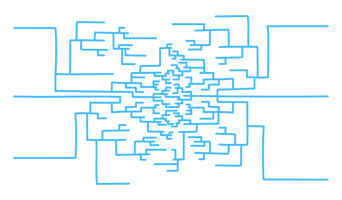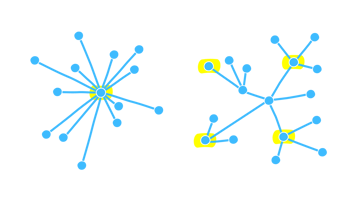One key idea behind decentralization is to give decision-making power to those who know best. Traditional approaches embed decentralized authority into a rigid framework of centrally defined checks and controls. Radical types of decentralization, on the other hand, extend the scope and the depth of decentralized decision-making in organizations.
The question of decentralization vs. centralization in building organizations is a classic question in organizational design. There are typical triggers that bring up the question of whether to centralize or decentralize a certain function.
One of those triggers is size. The larger the organizational scope, the more likely that ideas of decentralizing some decision-making away from the corporate center (or any central unit) become viable.
Another trigger is novelty: new functions and capabilities, for example relating to digitalization, are often thought to benefit less from central management directives than ancestral functions, which have been part of the organizational value chain for decades.
One key idea behind decentralization is to give decision-making power to those who know best
One key idea behind decentralization efforts is to give decision-making authority to those in the organization who know best — because the relevant information is available to them or because they are close to the stakeholders and the impact resulting from decisions.
For example, a local sales manager will typically benefit from a high degree of flexibility in shaping offers to unique customer needs. This allows her to respond to information that is only available to her in a specific context, without having to loop decisions via some central decision-maker, which runs the risk of losing time — and the sales.
On the other hand, some central decision-making rights may be considered non-negotiable for a number of different reasons, be it cost and standardization, brand consistency, or regulatory requirements. After carefully considering these trade-offs, decentralized authority can be granted to the degree that centralized guidance is considered a hindrance to a local (decentralized) decision.
Based on our organization design project experience, most large organizations have a tendency (or a culture) for either more centralized or more decentralized set-ups. And within those respective styles or tendencies, there are also cycles of increased or decreased centralization, following, for example, management changes or the degree of environmental change and internal adaptation required.
One important point about decentralization in organization design is that it will always be a matter of degree. Nevertheless, some innovative forms of organizing take decentralization of authority to unprecedented levels, and thus can be labeled “radically decentralized”, in contrast to more traditional approaches.
Work with the Organizational Structure Kit
to redesign your organization
Traditional approaches embed decentralized authority into a rigid framework of centrally defined checks and controls
Traditional approaches typically embed decentralized decision-making authority into a more or less rigid framework of guidances, policies, and controls.
The authority for decision-making is typically delegated (and not granted) to lower management layers, with each layer retaining the right to overrule certain lower-level decisions and to revoke certain authorities, as they see fit.
In addition, and on a fundamental level, the degree of decentralization results from a centrally defined organization design, which doesn’t need to be adapted in a meaningful way by the decentral unit.
Referring to our example above, the frontline sales manager or a region head might have far reaching decision-making power within their organizational silo. But in traditional setups, they would have very few governance mechanisms at their disposal to trigger adaptation processes in the wider organization or the overall strategy. Decentralization in the traditional sense follows a unidirectional vertical logic.
Radical types of decentralization extend the scope and the depth of decentralized decision-making in organizations
Radical approaches towards organizational decentralization, in contrast, extend the mechanism, the scope and the depth of this decentralization:
-
The mechanism is no longer one of revocable delegation by a superior, who retains the right to supersede a decision as he or she sees fit. In contrast, in a radical approach, specified decision rights are granted to organizational members. Think of the Holacracy role descriptions with their domains. Those roles may change, but as long as the roles are valid, there is no boss who could, based on his authority, overpower what the role owner intends to do.
-
The radicalism of the mechanism typically comes with an enlarged scope and depth, meaning that wider areas of organizational decision-making are governed according to a decentralized approach. The domains that lie with the decentralized, autonomous decision-maker are therefore expanded. For example, the autonomous decision maker may have full authority over how he does his work, without any interference or micromanagement from a boss. And in addition, the respective planning, coordination, and strategy would increasingly be subject to autonomous decision-making alone.
In their discussion of “self-managing organizations” (SMOs), Lee and Edmondson propose the defining feature of these organizations to be that they “radically decentralize authority in a formal and systematic way throughout the organization”. They use an historical analogy to illustrate this point: “if managerial hierarchy constitutes a system of feudalism where the vast majority of employees have no land ownership, then self-managing organizations introduce a system of property rights for all employees”.
The radicalism of the mechanism and the scope/depth are interlinked. Continuing with this analogy, it would hardly be worth it to grant property rights but then define the property in such small and limited terms that nothing meaningful can be done with it.
The Agile Organizing Kit and the Organize for Self-Management Kit provide key resources and tools to explore different routes towards increased decentralization.



